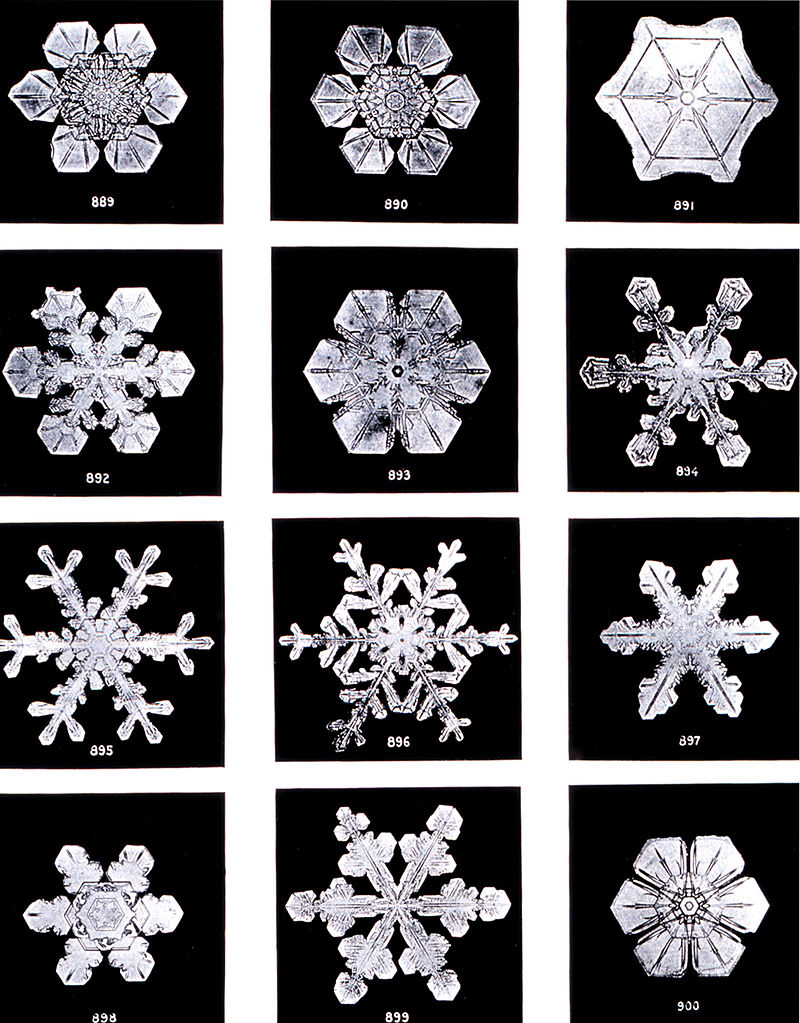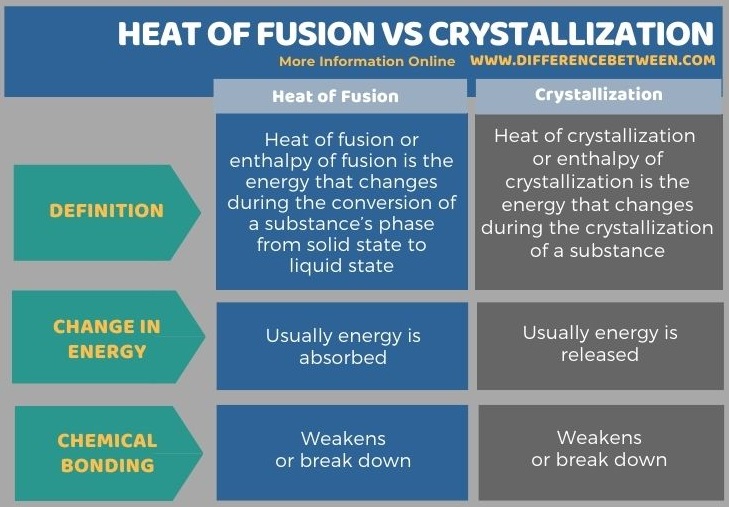Difference Between Heat of Fusion and Crystallization
Table of Contents
The key difference between heat of fusion and crystallization is that heat of fusion refers to the change in energy when a solid state of a particular substance converts into the liquid state whereas heat of crystallization refers to the heat that is either absorbed or evolved when one mole of a given substance undergoes crystallization.
Chemical reactions occur typically via absorption or release of energy. Here, the energy is evolved or absorbed mainly in the form of heat. Therefore, the change in energy for a particular reaction can be named as heat of that reaction or as the enthalpy of that reaction.
CONTENTS
1. Overview and Key Difference
2. What is Heat of Fusion
3. What is Heat of Crystallization
4. Side by Side Comparison – Heat of Fusion vs Crystallization in Tabular Form
5. Summary
What is Heat of Fusion?
The heat of fusion or enthalpy of fusion is the energy that changes during the conversion of a substance’s phase from solid-state to liquid state. Typically, energy changes occur in the form of heat, and the reaction should take place in a constant pressure in order to define a proper heat of fusion. The heat of solidification is the equal and opposite term for the heat of fusion.
The heat of fusion is defined for the melting of a substance. This energy change is named as latent heat because the temperature remains constant during the conversion process. If we consider the energy change per amount of substance in moles, then the term for this process can be given as molar heat of fusion.

Generally, the liquid phase of a substance has high internal energy compared to its solid phase because its kinetic energy is higher than potential energy. Therefore, we need to supply some energy to a solid in order to melt it down. In contrast, a substance releases energy when a liquid becomes a solid or freezes. This is mainly because of the molecules in the liquid experience weaker intermolecular interactions than molecules in the solid phase.
What is Heat of Crystallization?
The heat of crystallization or enthalpy of crystallization is the energy that changes during the crystallization of a substance. Crystallization may occur as either a natural process or as an artificial process. In the solid phase of a substance, the molecules or atoms are highly organized into a crystalline structure. We call this a crystal structure. A crystal can form in different ways such as precipitation from a solution, freezing, deposition directly from a gas (rarely), etc.

There are two major steps of crystallization: nucleation (a crystalline phase appears either in a supercooled liquid or a supersaturated solvent), and crystal growth (the increase in the size of particles and leads to a crystal state).
What is the Difference Between Heat of Fusion and Crystallization?
A chemical reaction occurs via absorption or evolving energy in the form of heat. The heat of fusion and heat of crystallization are two examples of this type of reactions. And, the key difference between heat of fusion and crystallization is that heat of fusion refers to the change in energy when a solid-state of a particular substance converts into a liquid state whereas heat of crystallization refers to the heat that is either absorbed or evolved when one mole of a given substance undergoes crystallization.
Below is a summary tabulation of the difference between heat of fusion and crystallization.

Summary – Heat of Fusion vs Crystallization
A chemical reaction occurs via absorption or evolving energy in the form of heat. The heat of fusion and heat of crystallization are two examples of this type of reactions. The key difference between heat of fusion and crystallization is that heat of fusion refers to the change in energy when a solid-state of a particular substance converts into the liquid state whereas heat of crystallization refers to the heat that is either absorbed or evolved when one mole of a given substance undergoes crystallization.
Reference:
1. “Heat of Fusion.” Chemistry LibreTexts, Libretexts, 14 July 2020, Available here.
Image Courtesy:
1. “Enthalpies of melting and boiling for pure elements versus temperatures of transition” By Mgibby5 (CC BY-SA 3.0) via Commons Wikimedia
2. “SnowflakesWilsonBentley” By Wilson Bentley – Plate XIX of “Studies among the Snow Crystals … ” by Wilson Bentley, “The Snowflake Man.” From Annual Summary of the “Monthly Weather Review” for 1902 (Public Domain) via Commons Wikimedia
ncG1vNJzZmivp6x7pbXFn5yrnZ6YsqOx07CcnqZemLyue8OinZ%2Bdopq7pLGMm5ytr5Wau260xJqrZqeWYrO2v8iopWaZnpl6pL7YrKuapJyex6LAyKilaA%3D%3D